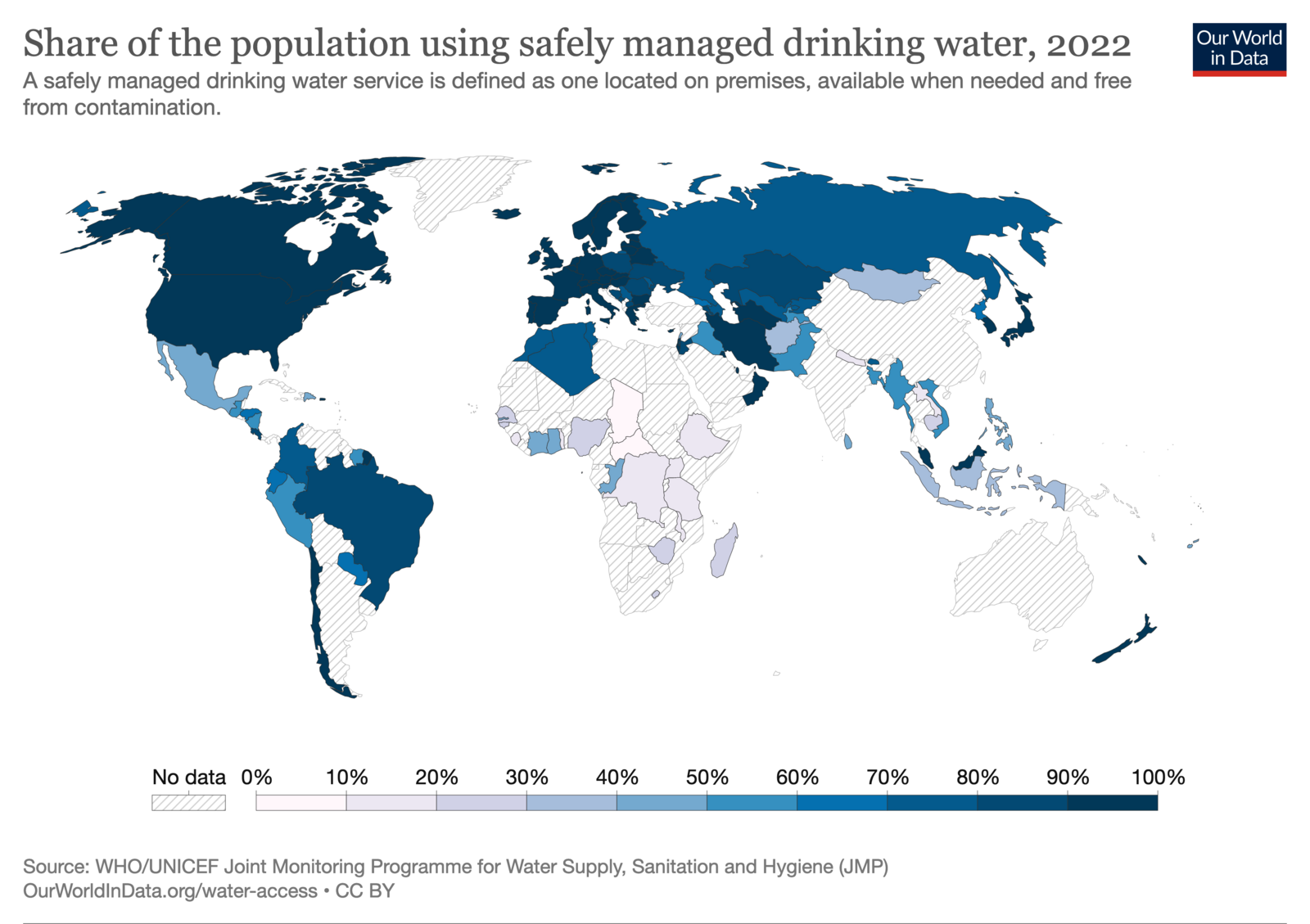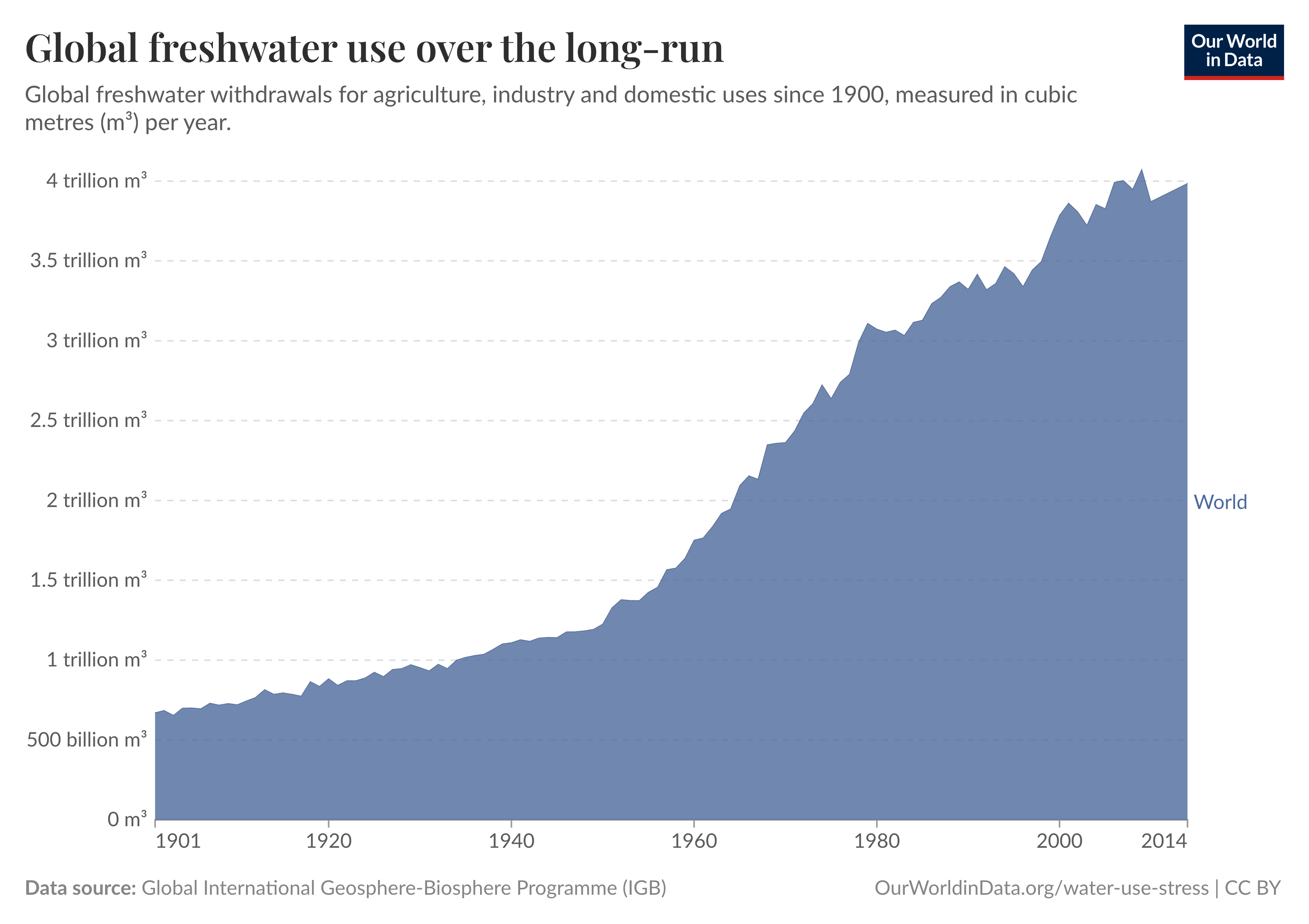IB Syllabus focus:
‘Social, cultural, economic and political factors shape equitable access. Water use spans households, agriculture (irrigation, livestock) and industry; growth demands extra supply or higher efficiency.’
Access to safe water is shaped by multiple factors, while its use varies across sectors. Understanding determinants and sectoral demands is crucial for water security planning.
Determinants of Water Access
Social Factors
Social factors strongly influence how communities access and use water.
Population density affects demand and stress on supplies.
Urban versus rural settings determine infrastructure investment and availability.
Education and awareness influence household efficiency and conservation practices.
Social determinants: Non-economic influences such as population distribution, education, and cultural values that shape how water is accessed and utilised.
Cultural Factors
Cultural practices and traditions often dictate patterns of water use.
Ritual and religious requirements may prioritise water for ceremonial use.
Cultural attitudes towards conservation determine efficiency adoption.
Traditional farming practices may require specific water-intensive methods.
Economic Factors
Economic resources determine whether water can be accessed and distributed equitably.
Investment in infrastructure (pipelines, reservoirs, pumps) requires financial capacity.
Wealthier nations and communities secure reliable access through advanced technology.
Poorer regions may rely on untreated surface water, increasing health risks.
Economic determinants: Financial resources and investments influencing infrastructure, distribution, and long-term water access.
Political Factors
Political stability and governance play a decisive role.
Effective governments establish equitable water policies and regulatory frameworks.
Corruption and mismanagement undermine fair allocation.
International disputes over transboundary rivers and aquifers can restrict access for vulnerable states.

World map showing the share of the population with safely managed drinking water by country. The map illustrates substantial spatial inequalities in access that arise from social, economic, cultural and political determinants. Source.
Water Use Sectors
Household Use
Water in households is directed towards basic needs:
Drinking and cooking.
Sanitation and hygiene.
Cleaning and domestic maintenance.
Efficiency measures include greywater recycling, low-flush toilets, and metering, reducing household strain on resources.
Household water use: The consumption of water for domestic purposes, including drinking, cooking, sanitation, and cleaning.
Agricultural Use
Agriculture is the largest water consumer globally, often accounting for around 70% of withdrawals.
Irrigation supports crop growth in water-scarce regions.
Livestock farming requires water for animals and feed production.
Expansion of intensive farming increases stress on freshwater reserves.
Agricultural demand is expected to rise with population growth and dietary shifts towards meat-intensive diets, which require higher water inputs.
Industrial Use
Industry consumes water for production, cooling, and cleaning processes.
Key sectors include textiles, energy generation, mining, and food processing.
Industrial wastewater, if untreated, can pollute rivers and aquifers.
Modern industries adopt closed-loop systems and recycling to reduce withdrawals.
Industrial water use: The utilisation of water in manufacturing, energy production, and related processes.

Global stacked-area chart of freshwater withdrawals by sector (agriculture, industry, domestic) since 1900. It highlights agriculture’s dominant share and long-run growth in sectoral demand, which informs planning for efficiency gains or supply expansion. Source.
Interactions Between Determinants and Sectors
Equity of Access
Equity depends on the balance of determinants and sectoral demands. For example:
A politically stable country may prioritise household and agricultural use over industrial expansion.
In developing regions, economic constraints force reliance on natural sources, limiting safe drinking water.
Cultural traditions can intensify agricultural water consumption despite scarcity.
Growth and Efficiency
Population growth and industrialisation increase water demand. Meeting this requires either:
Expansion of supply through new infrastructure.
Increased efficiency across all sectors.
Examples of efficiency improvements:
Households: smart metering, rainwater harvesting.
Agriculture: drip irrigation, drought-resistant crops.
Industry: recycling of process water.
Key Challenges
Inequality: Rural and marginalised communities often lack access to safe water.
Competition between sectors: Agriculture and industry may reduce availability for domestic use.
Climate change: Alters precipitation, reducing reliability of supplies.
Governance gaps: Corruption or weak institutions intensify scarcity even where resources exist.
Summary of Essential Concepts
Access to water is determined by social, cultural, economic, and political factors.
Water is primarily used across households, agriculture, and industry.
Rising demand requires either expanding supply or improving efficiency to maintain water security.
FAQ
Urbanisation increases pressure on water infrastructure, as growing populations concentrate demand in small areas. Cities often require extensive networks of pipelines and treatment facilities, which are costly to maintain.
Informal settlements may lack connections, forcing residents to rely on unsafe sources. In contrast, wealthier urban areas usually secure priority access, leading to inequality within the same city.
Cultural values shape daily practices and long-term choices in water use. For example, irrigation methods tied to traditional farming can remain water-intensive even when more efficient options exist.
Religious rituals, community customs, and attitudes toward conservation also affect whether people adopt water-saving technologies or continue with familiar, less efficient habits.
Shared rivers and aquifers often cross political borders. Agreements and treaties determine how much water each nation can withdraw.
When cooperation fails, disputes may arise, reducing access for downstream states. Political alliances and diplomatic negotiations are therefore critical in shaping fair and reliable water access across borders.
Rapid industrialisation raises water withdrawals for cooling, processing, and manufacturing.
Impacts include:
Competition with household and agricultural users.
Higher pollution risk from untreated wastewater.
Increased pressure on weak infrastructure, which struggles to distribute limited resources equitably.
Governments can:
Subsidise household connections for low-income communities.
Invest in decentralised water systems such as rainwater harvesting.
Implement transparent regulation to reduce corruption.
Negotiate international agreements for shared resources.
Strong governance ensures that access is determined by social need rather than purely economic or political power.
Practice Questions
Question 1 (2 marks)
Identify two factors that influence equitable access to safe water supplies.
Mark Scheme
Award 1 mark for each correctly identified factor.
Acceptable answers include:
Social (e.g., population distribution, education, awareness)
Cultural (e.g., traditions, religious practices, attitudes to conservation)
Economic (e.g., investment in infrastructure, wealth, poverty)
Political (e.g., governance, corruption, international disputes).
Maximum 2 marks.
Question 2 (5 marks)
Explain how agricultural and industrial water use contribute to increased water stress, and suggest strategies to improve efficiency in these sectors.
Mark Scheme
Agricultural water use (up to 2 marks):
1 mark for recognising agriculture as the largest water consumer globally.
1 mark for explanation, e.g., irrigation demands, livestock farming, expansion of intensive agriculture.
Industrial water use (up to 2 marks):
1 mark for identifying significant industrial uses such as cooling, processing, and cleaning.
1 mark for explaining impacts, e.g., high withdrawals, pollution risks, growing demand from industrialisation.
Strategies for efficiency (up to 2 marks, any two valid points):
Drip irrigation, drought-resistant crops, aquaponics, greenhouse cultivation.
Closed-loop industrial systems, water recycling, cleaner production techniques.
Quality of explanation and linkage to water stress (1 mark):
Award for coherent explanation of how demand in these sectors contributes to stress and how efficiency measures mitigate this.
Maximum 5 marks.

